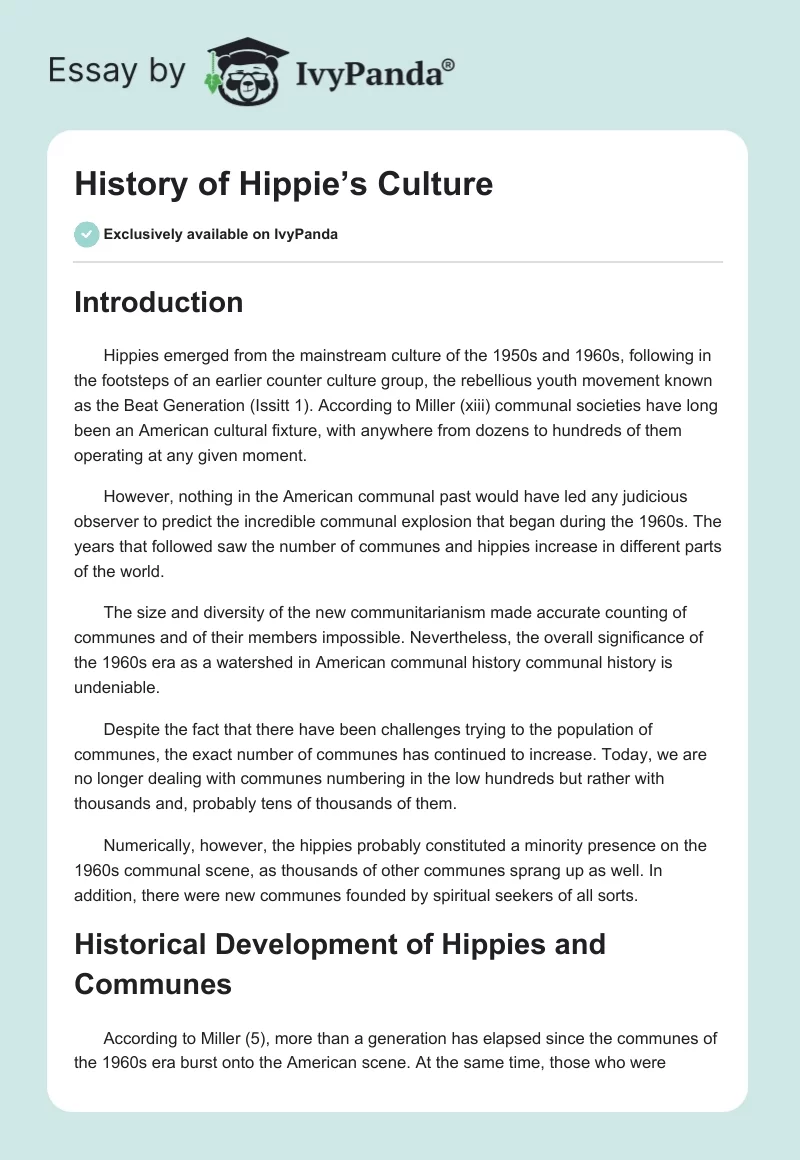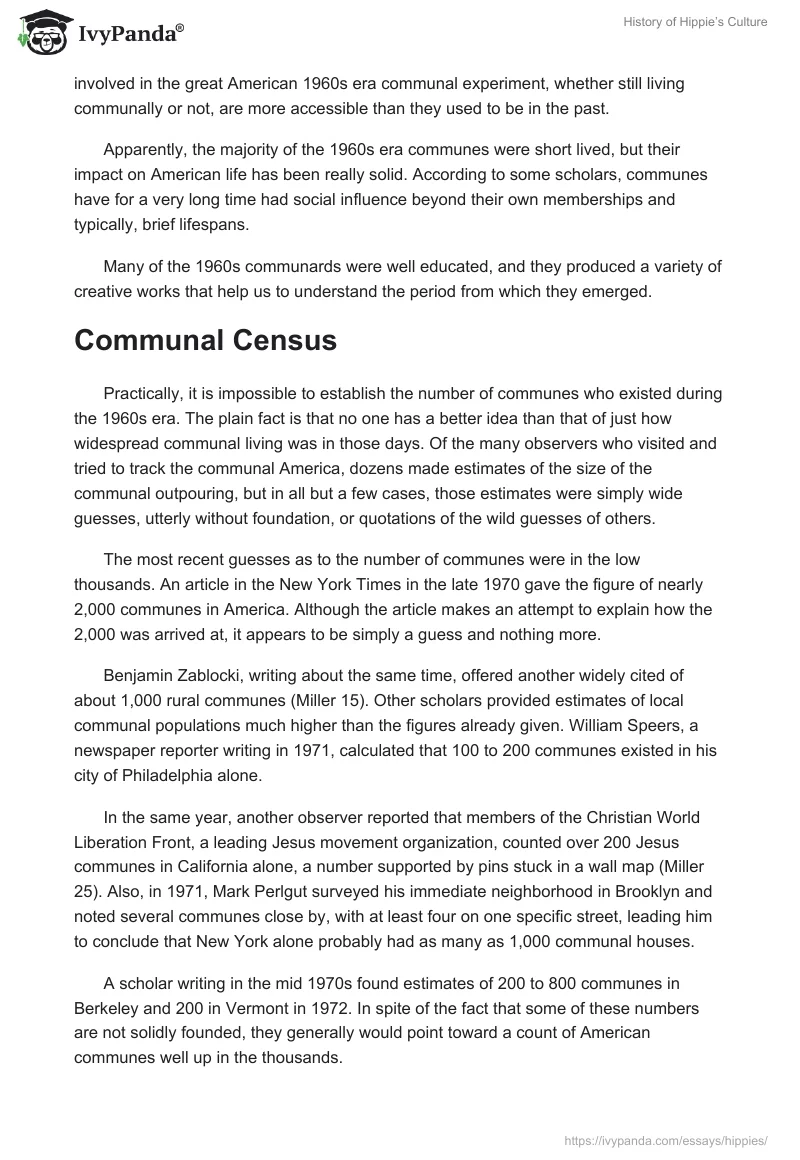Introduction
Hippies emerged from the mainstream culture of the 1950s and 1960s, following in the footsteps of an earlier counter culture group, the rebellious youth movement known as the Beat Generation (Issitt 1). According to Miller (xiii) communal societies have long been an American cultural fixture, with anywhere from dozens to hundreds of them operating at any given moment.
However, nothing in the American communal past would have led any judicious observer to predict the incredible communal explosion that began during the 1960s. The years that followed saw the number of communes and hippies increase in different parts of the world.
The size and diversity of the new communitarianism made accurate counting of communes and of their members impossible. Nevertheless, the overall significance of the 1960s era as a watershed in American communal history communal history is undeniable.
Despite the fact that there have been challenges trying to the population of communes, the exact number of communes has continued to increase. Today, we are no longer dealing with communes numbering in the low hundreds but rather with thousands and, probably tens of thousands of them.
Numerically, however, the hippies probably constituted a minority presence on the 1960s communal scene, as thousands of other communes sprang up as well. In addition, there were new communes founded by spiritual seekers of all sorts.
Historical Development of Hippies and Communes
According to Miller (5), more than a generation has elapsed since the communes of the 1960s era burst onto the American scene. At the same time, those who were involved in the great American 1960s era communal experiment, whether still living communally or not, are more accessible than they used to be in the past.
Apparently, the majority of the 1960s era communes were short lived, but their impact on American life has been really solid. According to some scholars, communes have for a very long time had social influence beyond their own memberships and typically, brief lifespans.
Many of the 1960s communards were well educated, and they produced a variety of creative works that help us to understand the period from which they emerged.
Communal Census
Practically, it is impossible to establish the number of communes who existed during the 1960s era. The plain fact is that no one has a better idea than that of just how widespread communal living was in those days. Of the many observers who visited and tried to track the communal America, dozens made estimates of the size of the communal outpouring, but in all but a few cases, those estimates were simply wide guesses, utterly without foundation, or quotations of the wild guesses of others.
The most recent guesses as to the number of communes were in the low thousands. An article in the New York Times in the late 1970 gave the figure of nearly 2,000 communes in America. Although the article makes an attempt to explain how the 2,000 was arrived at, it appears to be simply a guess and nothing more.
Benjamin Zablocki, writing about the same time, offered another widely cited of about 1,000 rural communes (Miller 15). Other scholars provided estimates of local communal populations much higher than the figures already given. William Speers, a newspaper reporter writing in 1971, calculated that 100 to 200 communes existed in his city of Philadelphia alone.
In the same year, another observer reported that members of the Christian World Liberation Front, a leading Jesus movement organization, counted over 200 Jesus communes in California alone, a number supported by pins stuck in a wall map (Miller 25). Also, in 1971, Mark Perlgut surveyed his immediate neighborhood in Brooklyn and noted several communes close by, with at least four on one specific street, leading him to conclude that New York alone probably had as many as 1,000 communal houses.
A scholar writing in the mid 1970s found estimates of 200 to 800 communes in Berkeley and 200 in Vermont in 1972. In spite of the fact that some of these numbers are not solidly founded, they generally would point toward a count of American communes well up in the thousands.
The First Communes in East and West Coast
According to Oved (64) the first communes begun to appear in California in 1965. The background to their creation was the same as that of the original appearance of the hippies. It resulted from protests against the changes in the American society, and aversion of materialism, as well as the experiences of young members of the New Left in the struggle against the Vietnam War.
The disillusion from politicians that became stronger after the events of the Democratic conference in Chicago also led to a major turning point. Although political groups became more violent, there were also many who sought a new way of life. The romance of a return to values that had been abandoned by the prevalent culture which included the return to the community, to social obligation, to relationships with each other, and to nature and the land, also played its part (Smith 25).
The communal movement of the sixties began in the eastern and western regions of the United States, and spread from there to the center of the continent. Beginning in California it reached Oregon, and, later northern New Mexico and Colorado, and on the East coast, from Vermont southward to Virginia.
This wave was at its height from 1967 to the early seventies. After its initial stage in the mid sixties, the trickle became a flood and young people established communes in hundreds of localities in and outside the big cities. Many scholars and journalists have tried to estimate their numbers. Newsweek claimed that in 1969 there were some five hundred communes, with ten thousand members.
Benjamin Zablocki distinguished between rural and urban communes, and estimated that in 1971, there were about one thousand rural and about two hundred urban communes. The urban communes were small, with no defined doctrine. They were pluralist and poor, practiced partial cooperation with no independent productive branch, and generally lived in rented accommodation. Considering that the communes were not included in the urban census reports, it became quite hard to estimate their exact number.
In Boston, attempts to determine their numbers in the autumn of 1972 concluded that there were approximately 200 in the city, 350 in San Francisco, another 200 in Berkeley, and about a thousand in New York (Oved 64). In addition, there were similar communes in most of the big towns, particularly those with a number of universities. Despite their impressive numbers, the urban communes are not a representative sample of communalism, since they encompass many temporary phenomena connected the students’ way of life.
According to the New York Times, there were some two thousand communes in thirty four states in the year 1970. In his book, Families of Eden, Jerome Judson claimed that at the beginning of the seventies, the communes numbered 5,000, and that rural communes had a membership of about 250,000.
Richard Fairfield’s estimate, in the preface of his book, Modern Utopia, is similar. He maintains that the average membership of the rural communes is between twenty and forty and that most of the members were in their twenties (Oved 66). Apparently, the rapid expansion of the communes was connected with the development of the media such as television, radio, and the press.
There is no doubt that publicity in Time, Newsweek, and Life encouraged the growth of the communes. Through the media, local events made a resounding impression and influenced parallel processes on the national level. Interest in communes reached its peak between 1968 and 1971, when the media displayed considerable interest on the phenomenon. They saw in it and outstanding expression of the counter culture and the realization of its deals (Smith 35).
Conclusion
Although the hippies’ individualism and anarchism would seem to conflict with their tendency to foster communal life, whether in small groups traveling together over highways in America, or in urban communes or more stable rural communes. For most of the young people who adopted this life style, the commune was not a permanent way of life. It was simply a temporary refuge that gave them a place of retreat in which they could reassess the individual’s disappointment with the society.
Clearly, the escapist tendencies of most of the hippies who joined communes led them to form a picture in their minds of the society from which they were fleeing, rather than an imaged of an ideal society.
Works Cited
Issitt, Micah. Hippies: A Guide to an American Subculture, Santa Barbara, California: ABC-CLIO, 2009. Print.
Miller, Timothy. The 60s Communes: Hippies and Beyond, Syracuse, New York: Syracuse University Press, 1999. Print.
Oved, Yaacov. Globalization of Communes: 1950-2010, New Brunswick, New Jersey: Transaction Publishers, 2012. Print.
Smith, Sherry. Hippies, Indians, and the Fight for Red Power, Oxford, UK: Oxford University Press, 2012. Print.


